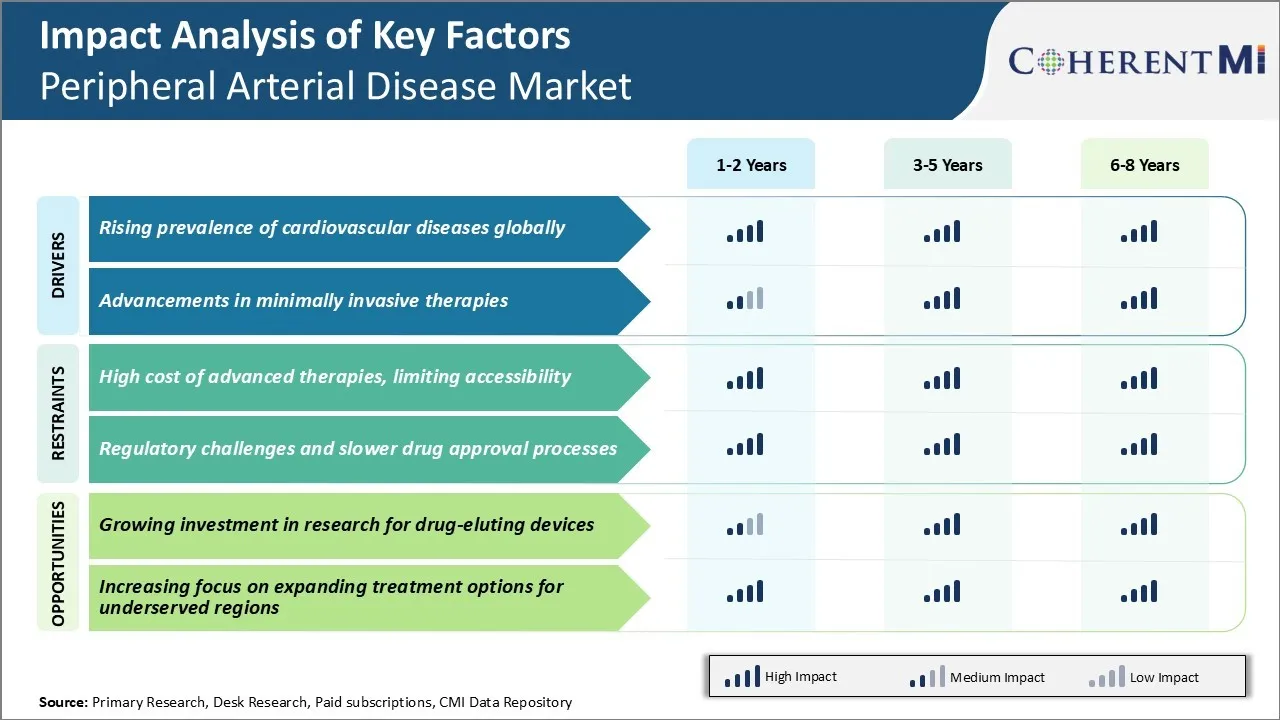Mercato delle malattie arteriose periferiche ANALISI DIMENSIONE E QUOTA - TENDENZE DI CRESCITA E PREVISIONI (2024 - 2031)
Il mercato della malattia arteriosa periferica è segmentato dal trattamento (terapia ondulare, terapia endovascolare), dalla malattia (malattia arteri....
Mercato delle malattie arteriose periferiche Tendenze
Driver di mercato - Prevalenza crescente delle malattie cardiovascolari e capacità diagnostiche migliorate
Poiché l'aterosclerosi colpisce una grande popolazione in tutto il mondo, di conseguenza porta ad un aumento del numero di persone che vivono sintomi PAD e che richiedono il trattamento. Gli esperti hanno notato che l'incidenza del PAD aumenta tipicamente con l'età ed è più alta nelle persone con diabete di lunga data o una storia di fumo. Si prevede che i paesi in via di sviluppo con popolazioni in età avanzata e una maggiore accettazione dello stile di vita sedentario contribuiscano in gran parte alla piscina del paziente PAD.
Un altro fattore che guida i casi PAD è migliorare le capacità diagnostiche. I progressi nelle tecnologie di imaging non invasivo hanno permesso ai medici di rilevare anche le fasi miti del PAD che potrebbero essere andati inosservati prima. Maggiore consapevolezza tra i medici e le persone per quanto riguarda i sintomi del PAD sta anche portando a ulteriori casi di essere raccolti per un ulteriore esame e gestione. Mentre questo può gonfiare temporaneamente i numeri, in definitiva aiuta a identificare i gruppi a rischio e consente l'intervento clinico tempestivo per affrontare la condizione e prevenire il compromesso degli arti.
Nel complesso, poiché le malattie cardiovascolari continuano ad imporre un peso significativo della malattia in tutto il mondo a causa dei cambiamenti demografici e delle tendenze dello stile di vita sottostanti, la prevalenza del PAD come possibile conseguenza è probabile seguire una traiettoria ascendente.
Driver di mercato - Avanzamenti in Terapie Invasive Minimo
Il rapido progresso tecnologico all'interno del segmento dei dispositivi medici ha trasformato notevolmente il paesaggio di trattamento PAD, uno dei principali conducenti essendo l'emergere di metodologie avanzate minimamente invasive. Alcuni dei principali sviluppi che hanno migliorato i risultati clinici, facilitando meno trauma includono mongolfiera e dispositivi atherectomy meccanici.
Basandosi sui primi successi, i produttori hanno portato al mercato palloncini rivestiti di droga di nuova generazione, stents PAD dedicati e sistemi di atherectomy incorporando preziosi miglioramenti di progettazione. Inoltre, i progressi nei campi della robotica e della stampa 3D stanno dando origine a terapie innovative come regolatori di flusso renale impiantabili. A lungo termine, tali progressi potrebbero contribuire a ridurre al minimo i rischi di amputazione soprattutto per i pazienti affetti da ischemia degli arti critici attraverso soluzioni interventistiche personalizzate.
I fornitori di assistenza sanitaria inoltre stanno mostrando una maggiore preferenza per la gestione PAD minimamente invasiva data prova di vantaggi tangibili come i soggiorni ospedalieri più brevi, i tempi di recupero più rapidi, i rischi di complicazione più bassi e le capacità di recupero degli arti superiori rispetto alle operazioni aperte.
Di conseguenza, l'assorbimento di dispositivi endovascolari all'avanguardia e le tecniche sta assistendo ad un sostanziale aumento in tutto il mondo che sta propellendo la crescita globale del mercato. Guardando avanti, i miglioramenti continuati nei prodotti a base di catetere tengono notevole potenziale per trasformare ulteriormente la cura del PAD.

Sfida di mercato: alto costo delle terapie avanzate, limitazione dell'accessibilità
Una delle principali sfide affrontate dal mercato della malattia arteriosa periferica (PAD) è l'alto costo delle terapie avanzate. Man mano che la malattia progredisce, sono necessarie procedure più complesse come l'angioplastica del pallone e il stenting per aprire le arterie bloccate e migliorare il flusso sanguigno.
Tuttavia, queste procedure comportano l'uso di costosi dispositivi medici e tecnologie. Ad esempio, stents di diluizione della droga che vengono utilizzati per prevenire il ri-narrowing delle arterie post-procedure costano ovunque tra $3000 a $5000 per stent. Allo stesso modo, i dispositivi atherectomy utilizzati per rompere e rimuovere i blocchi costano oltre $10000 per dispositivo.
L'onere economico di tali trattamenti costosi sta limitando la loro accessibilità soprattutto nei paesi in via di sviluppo e per gli individui senza una copertura assicurativa adeguata. Come per la nostra analisi, quasi il 25-30% dei pazienti PAD che richiedono interventi avanzati non subiscono la procedura a causa di problemi di convenienza. Questo ha significative implicazioni per la salute e molti progrediscono alla fase critica del meticolismo senza un trattamento immediato.
Diversi mercati come India, Cina, Brasile ecc che sono previsti per vedere la crescita enorme nella base del paziente può vedere che ha avuto un impatto a causa di questa sfida. Gli operatori stanno affrontando la pressione dei prezzi che può ostacolare la crescita dei ricavi se non affrontata.
Opportunità di mercato - Investimenti in crescita nella ricerca per i dispositivi di valutazione della droga per il mercato
Una delle principali opportunità per il mercato PAD consiste nel crescente investimento e nella ricerca nel settore dei dispositivi per l'eliminazione delle droghe. Dispositivi convenzionali come l'angioplastica a mongolfiera e gli stenti bare-metal richiedono una ri-intervenzione nel 30-50% dei casi a causa del ri-narrowing delle arterie nel tempo. Questo ha spinto una vasta ricerca sulle tecnologie di riduzione della droga che possono fornire farmaci localmente nel corso di un periodo per prevenire questo re-stringimento.
Diverse startup e grandi giocatori stanno mettendo le risorse nello sviluppo di palloncino rivestito di droga e stents. Alcuni dei farmaci sotto indagine includono paclitaxel, sirolimus ecc. che possono promuovere la guarigione e inibire la proliferazione cellulare responsabile del ri-blocco.
Se si è sviluppato con successo, tali tecnologie di riduzione della droga possono rivelarsi altamente distruttive per il mercato. Può fornire tassi di patency a lungo termine paragonabili a interventi di bypass in modo minimo invasivo. Ciò contribuirà non solo ad affrontare la sfida delle procedure ripetute, ma anche a migliorare la conformità e l'esperienza dei pazienti.
Data l'importanza dell'opportunità, il finanziamento delle imprese in questo settore è aumentato nel corso degli ultimi anni. I prodotti di successo possono ottenere una quota di mercato enorme e prezzi premium in termini brevi e medi. È quindi un viale lucrativo per l'innovazione e la crescita nel segmento dei dispositivi vascolari.